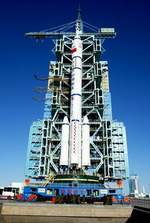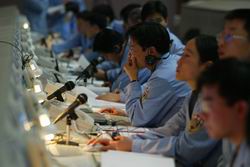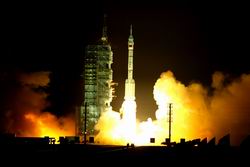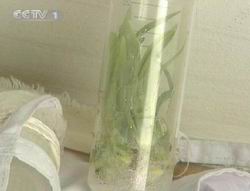 Shenzhou IV, an upgraded unmanned spacecraft, was on December 30, 2002 at 00:40 in China’s northwestern Gansu Province. It was propelled by a “Long March II F” carrier rocket. Yuan Jiajun, General Director, Space Program, said: “First, we’ve made efforts for better security measures to ensure a safe escape. Considerable improvements were achieved in regard to life-saving methods in outer space so that the astronauts will have a much better chance of survival in case of an emergency. Second, we added a manual operational system that can be used by the astronauts in case the automatic system fails. This is a backup function for the safety of the astronauts as well as the spacecraft. Third, based on previous flight experiments, Shenzhou III in particular, we’ve increased the reliability of the spacecraft as a whole.” Shenzhou IV, an upgraded unmanned spacecraft, was on December 30, 2002 at 00:40 in China’s northwestern Gansu Province. It was propelled by a “Long March II F” carrier rocket. Yuan Jiajun, General Director, Space Program, said: “First, we’ve made efforts for better security measures to ensure a safe escape. Considerable improvements were achieved in regard to life-saving methods in outer space so that the astronauts will have a much better chance of survival in case of an emergency. Second, we added a manual operational system that can be used by the astronauts in case the automatic system fails. This is a backup function for the safety of the astronauts as well as the spacecraft. Third, based on previous flight experiments, Shenzhou III in particular, we’ve increased the reliability of the spacecraft as a whole.”
Shenzhou IV consists of a propelling module, an orbital module and a re-entry module. The latter carried two important passengers, namely the dummies that represented the astronauts. Su Shuangning, Commander and Lead Designer of Astronaut System, said: “To keep on a par with the state of manned flight, we used dummies to simulate the weight, size, structure and centroid of an astronaut.”
 So what kinds of measurement devices did the dummies carry? One is a shock-measuring device for the measurement of superheavy value and shock value. It’s used to check whether these two sets of data meet the medical requirements. There is also the telecommunication equipment and devices for measuring radiation. Because the spacecraft is built to carry real astronauts, it’s necessary to put some anthropomorphic load into the spacecraft to find how to meet the need of manned spacecraft through unmanned flight.
So what kinds of measurement devices did the dummies carry? One is a shock-measuring device for the measurement of superheavy value and shock value. It’s used to check whether these two sets of data meet the medical requirements. There is also the telecommunication equipment and devices for measuring radiation. Because the spacecraft is built to carry real astronauts, it’s necessary to put some anthropomorphic load into the spacecraft to find how to meet the need of manned spacecraft through unmanned flight.
The anthropomorphic load system includes a human metabolic simulater, an anthropomorphic physical signal device and dummies, which are used to simulate the relevant functions of human beings. Before the launch of Shenzhou IV, a backup pilot entered the spacecraft for on-site training.
Before Shenzhou IV left the factory, we conducted a joint test at the spacecraft-testing center. The purpose was to give the astronaut a chance to familiarize himself with the environment of the spacecraft at first, and then, more importantly, to feel whether the internal designs are reasonable, and all devices on the instrument panel are easy to manipulate.
 Manned flight program consists of seven parts, among which the launching process is only the beginning of the flight experiment. The working staff members of the ground launching site system and the rocket system will cheer for a successful launch upon seeing the spacecraft enter its orbit, while engineers of the other systems become heavily involved at this point. Yu Zhijian, Chief Designer of Observe and Control System, Manned Flight Program, said: “The work of observation and control of the spacecraft by the system starts once the spacecraft enters its orbit. After the injection, there are seven days of moving in orbit and half-year of stay-in-orbit utilization, during which the observe and control system will organize a comprehensive network made up of two control centers and five domestic stations as well as four measurement ships distributed across three big oceans. The mission of the network is to conduct a round-the-clock tracking and measuring of the spacecraft, to monitor the flight of the spacecraft, to transmit orders and collect data, to control the state of flight, and to engage in a variety of scientific experiments.”
Manned flight program consists of seven parts, among which the launching process is only the beginning of the flight experiment. The working staff members of the ground launching site system and the rocket system will cheer for a successful launch upon seeing the spacecraft enter its orbit, while engineers of the other systems become heavily involved at this point. Yu Zhijian, Chief Designer of Observe and Control System, Manned Flight Program, said: “The work of observation and control of the spacecraft by the system starts once the spacecraft enters its orbit. After the injection, there are seven days of moving in orbit and half-year of stay-in-orbit utilization, during which the observe and control system will organize a comprehensive network made up of two control centers and five domestic stations as well as four measurement ships distributed across three big oceans. The mission of the network is to conduct a round-the-clock tracking and measuring of the spacecraft, to monitor the flight of the spacecraft, to transmit orders and collect data, to control the state of flight, and to engage in a variety of scientific experiments.”
Besides, the key mission of the network is to control the return of the spacecraft on the seventh day of the flight to the main landing site. As in the preparation for the spacecraft’s launch, all laboratory work is counted down in concert with the launch time.
The goal is to ensure zero errors and zero misjudgements through recording each step of maneuvering and checking. To achieve this goal, we must conduct each process in strict conformation with the original detailed rules and regulations and operating instructions. Success is what we must secure.
 In this module, the scientific research personnel are producing and extracting the cell culture solution. In another module, other researchers are conducting the preparation of plant cells. Both of these two kinds of cells are tabacco cells. The light-green one is a makhorca cell. The dark-green one is the cell of the Innovation No.1 tobacco. These two cells will be electrofused in outer space. They want to nurture a new specimen. Why is the specimen nurtured in outer space? Because the two kinds of cells differ greatly in their densities, they are very likely to deposit on two different layers when we conduct the experiment on Earth. To achieve the electrofusion and synthesis, the two kinds of cells should be given a high-tension pulse after they are tightly joined. So we exploit the weightless environment in outer space to obtain more of this kind of hybrid cell.
In this module, the scientific research personnel are producing and extracting the cell culture solution. In another module, other researchers are conducting the preparation of plant cells. Both of these two kinds of cells are tabacco cells. The light-green one is a makhorca cell. The dark-green one is the cell of the Innovation No.1 tobacco. These two cells will be electrofused in outer space. They want to nurture a new specimen. Why is the specimen nurtured in outer space? Because the two kinds of cells differ greatly in their densities, they are very likely to deposit on two different layers when we conduct the experiment on Earth. To achieve the electrofusion and synthesis, the two kinds of cells should be given a high-tension pulse after they are tightly joined. So we exploit the weightless environment in outer space to obtain more of this kind of hybrid cell.
There is also one pair of zooblasts, or animal cells, for the cell eletrofusion experiment in outer space. One is a lymph cell extracted from the spleen of a mouse, and the other is the myeloma cell of a mouse. It means that we are engaging in the production of an antibody that can be nutured extracorporally and for a long time.
It’ll make it unnecessary to get antibodies from serum extracted and made from blood. If we are able to succeed in the nurturing experiment, we’ll get a large amount of antibodies for use in diagnosis, medical treatment and scientific research.
In the wee hours of January 6th this year, these biological samples, which have been of great concern to relevant researchers, were taken to Beijing. On the following day, they were taken by researchers to Shanghai for further observation and study. Hu Shixiang, Vice Commander of Manned Flight Program, said: “Shenzhou IV was launched successfully as many people witnessed. This signals that our spacecraft, rocket, other ground facilites and operating systems are very satisfactory. Although we still have a lot of work to do, the full success of the Shenzhou IV flight indicates that it won’t be long before Chinese astronauts travel into space aboard the spacecraft made in China.”
Editor:Wang Yin
|